Hanchurch Service Reservoir (2018)
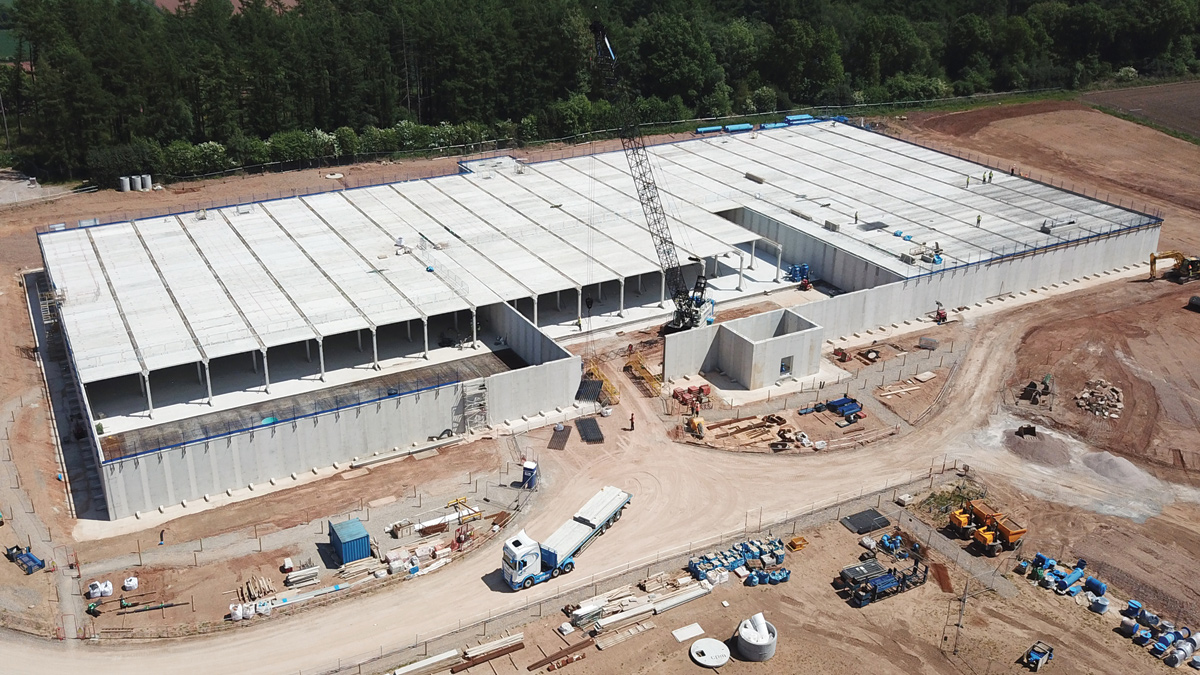
The new service reservoir under construction - Courtesy of MMB/Suave Aerial Photographers
A ‘product-based’ approach to service reservoir construction is revolutionising the way MMB are constructing a new multi-million-pound distribution service reservoir (DSR) for Severn Trent Water (STW). To boost productivity in the construction process, the new 43ML reservoir is being treated as a ‘product’, manufactured largely off site in controlled-conditions, before being assembled on site near Stoke-on-Trent. This approach is reducing programme time and H&S hazards, as well as increasing the quality of finish due to manufacturing in factory conditions. All these factors are contributing to an improved project outcome and greater client satisfaction.
Planning
Collaborative planning sessions were undertaken on a weekly basis during the design phase, ensuring representatives of the land and planning agent, Severn Trent Water (STW), the construction team and Mott MacDonald ground investigation specialists were involved. A Stafford Borough Council planning committee was also hosted on site to discuss the proposal/scope of project and reason for the scheme. Mitigation measures for various elements were discussed and reviewed, including the location of pipework adjoining the new and old reservoir reducing the need for tree removal as far as possible.
The access route was also adjusted to eliminate tree removal, and the installation of the fencing and stone path parallel to the existing public right of way to allow diversion of a footpath which facilitated access to site. A representative of the Ramblers Association was also consulted to agree the extent of a diversion and to ensure details of the proposed route were communicated to the rambling community as the location of the new reservoir is in a popular walking area. The projects’ planning permission was granted by Stafford Borough Council with no conditions.
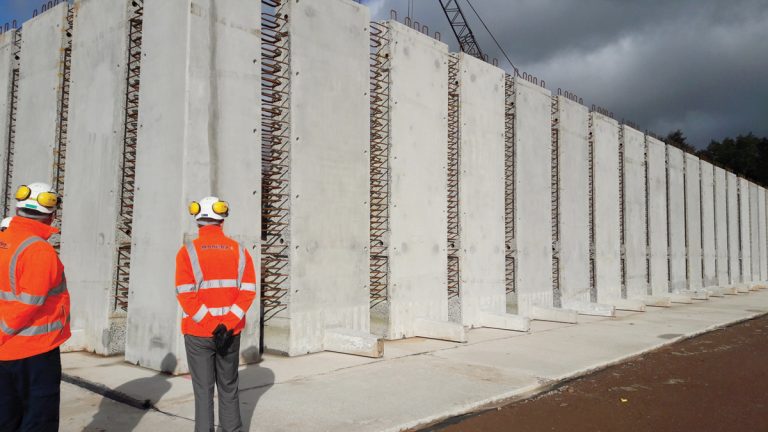
Using PCC units increases the quality through manufacturing in a controlled ‘factory’ environment- Courtesy of MMB
Solution
The DSR will ensure the reliability of the water supply for years to come. To boost productivity in construction, and ultimately deliver greater client satisfaction, the project adopted a ‘product-based’ approach; an initiative developed and honed over 40+ reservoir projects in the last three AMP cycles.
MMB has developed a series of standard products; components designed once but installed many times. The principles of this boost productivity in:
- Design: Faster process; 3D-models built using standard units; construction sequence optimised using model.
- Procurement: Less time obtaining prices.
- Construction: Workforce more familiar with components.
- Completions: Less time gathering information.
- Reputation: Greater client value.
At Hanchurch a precast concrete (PCC) service reservoir product was utilised, using best practice guides and lessons-learnt from previous schemes, to further hone the process and derive greater benefits.
The PCC ‘product-based’ approach to DSR construction developed as MMB was awarded an increasing number of ‘batches’ of design and construct projects. Given similarities in construction from one DSR to the next, there was an obvious opportunity to boost productivity by using the same approach for all. MMB has a developed the units with supplier Carlow Precast (now FLI Precast Solutions) throughout a long-standing relationship, which gives confidence in the service and outcomes that can be provided to clients.
The construction process was based on crane lifting capability and concrete delivery restrictions due to limited site access. Crane lifting was modelled in a 3D model to determine the base slab pour sizes to ensure the crane could still lift the beams and roof planks once the base pour complete. Due to commonality of precast wall units, over 95% of wall stitches were identical, therefore formwork could be reused and steel stored on site was reduced as there was no need for contingency steel. Furthermore, the valve houses were designed to utilise same wall units as main reservoir structure, again reducing variability during installation.
Significant earthworks were completed to the south east. Structural fill of over 3m was built up in 150mm layers and tested. All results recorded and presented to qualified Panel Engineer prior to commencing construction.
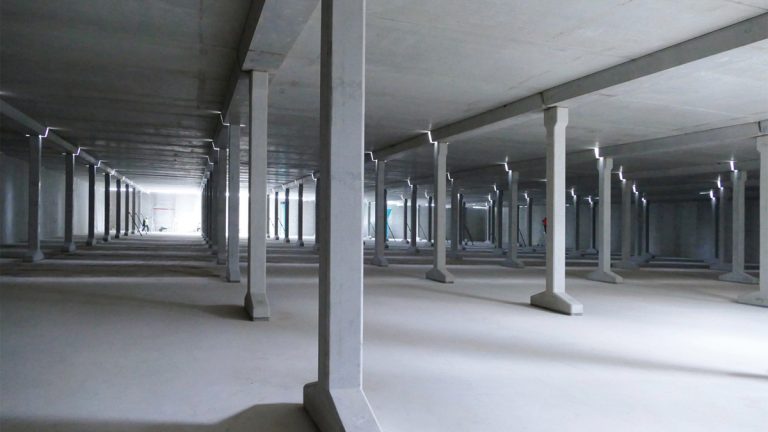
Internal view of the service reservoir, utilising PCC columns, beams and roof planks – Courtesy of MMB
Programme
The use of PCC rather than traditional in situ reduced the programme by 8 weeks by allowing work to be undertaken throughout the winter. The build involves installation of 1,650 PCC units, all manufactured off site. The 1.6m wide wall units are being installed at a rate of 10 (No.) per day; traditionally you could expect to install just 30-40m of walls per week.
To eradicate long-lead times for specials, the wall unit design has been standardised, making production faster as there are just five different types of wall unit at Hanchurch, demonstrating continuous improvement in MMB’s service reservoir design and build capabilities.
Due to the volume of units required, MMB worked closely with Carlow Precast to detail requirements and place orders early. This meant most units were manufactured and stored in their yard ahead of programme and could be delivered to site on an as needed basis, with a minimum of one week’s notice.
The factory approach was also adopted for the base, where installation of special prefabricated welded mesh was sequenced to enable working in three areas simultaneously. The base saved a need for 750,000 manual ties, saving 8-10 weeks on a traditional approach.
Safer site
A safer site is a more productive site. By installing PCC units rather than casting in situ, the number of hours worked was significantly reduced; at Hanchurch this meant 75% less site labour.
One area of focus for is low risk/high frequency activity, of which there is lots associated with traditional in situ construction. The ‘product-based’ approach reduced the need for many such tasks, including:
- Propping large formwork.
- Cutting and tying reinforcement. Typically water retaining structures require a large number of bars at close centres further increasing the difficulties associated with in situ construction.
- Exposure to wet concrete/dust from rework.
- Reduced storage/quantity of materials on site.
This approach also reduces the volume of potentially hazardous activity, everything from less temporary works to reduced time working at height.
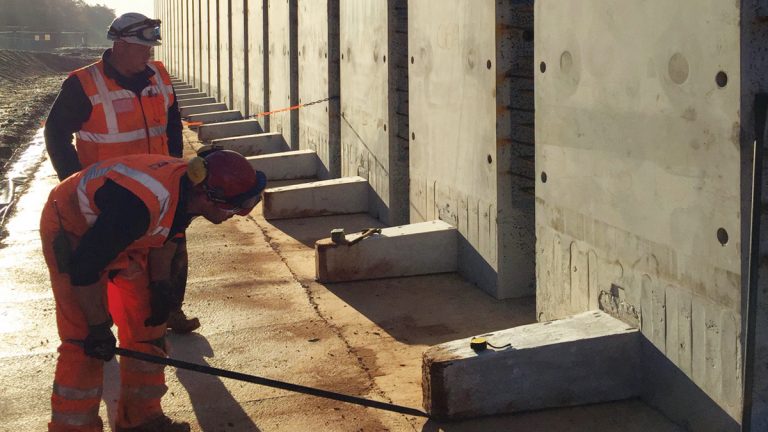
Precision placement of precast concrete wall units on site – Courtesy of MMB
Right first time
Re-work is a major contributor to a non-productive build; the ‘product-based’ approach guards against this. Using good quality timber shutters for joints prevents the need for re-work and future water quality issues, and casting in Dividag to the PCC unit reduces leakage risk. Factory-cast wall couplers also reducing leakage risk as well as improving the quality of finish.
Environmental aspects
The reservoir’s location and orientation was based on matching existing reservoir operational levels, whilst ensuring zero net cut/fill. The north-west corner of the reservoir was excavated to over 3m and was used to create an area of structural fill in an elevated location for the site cabins relative to existing ground level. A drone was flown over site on a monthly basis to record construction progress, and to ensure the client was informed of works progress. The drone also used to complete a topo survey which was later converted into a ground surface in the reservoir model. A second topo of the site was completed using the following the earthworks operations, to allow a check of initial cut/fill analysis.
Upon completion the existing reservoir to be decommissioned and used as large infiltration area for new DSR roof drainage to ensure surface water run-off from the site does not increase because of the development.
Innovation
An innovative leakage detection system will be installed to monitor the performance of the structure during asset life. Over 5km of fibre optic cables are to be installed around the DSR to detect changes in ground temperature caused by water movement.
This new technology provides live monitoring of the integrity of the structure, enabling early identification of potential leakage. It should allow to pin point exactly where the leak is and fix it quickly, guaranteeing that the water in the reservoir stays at the highest quality.
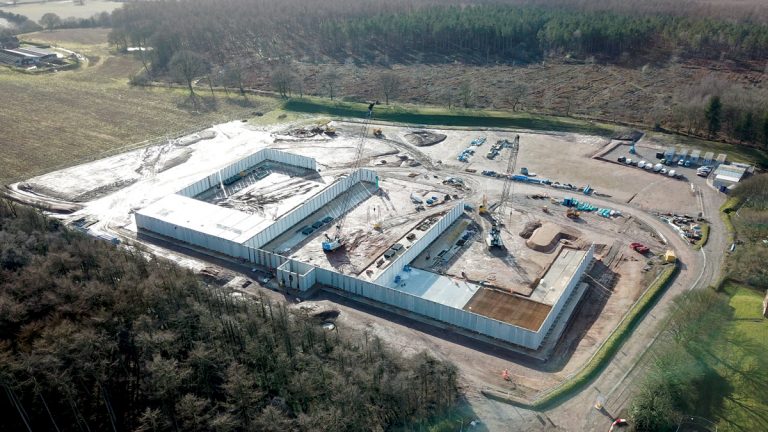
Aerial view of the service reservoir under construction – Courtesy of MMB/Suave Aerial Photographers
Conclusion
The use of off-site manufactured products which reduced the length of time MMB was on site, minimised the impact on the local community. Using a ‘product-based’ approach has realised increased site productivity and reduced risk of weather delays to the programme, whilst taking care of the workforce and reducing exposure to construction hazards.
The Hanchurch Distribution Service Reservoir project team’s collaborative approach ensured the planning, design and delivery of the project will meet the outcomes required whilst aiming to continually improve our best practice to seek further efficiencies and share them with other delivery teams.







